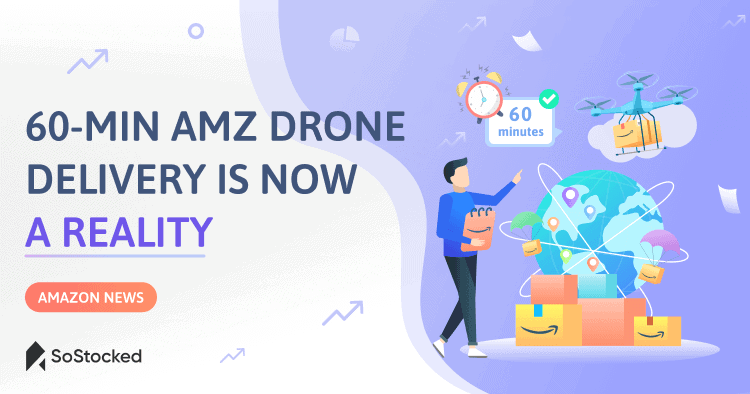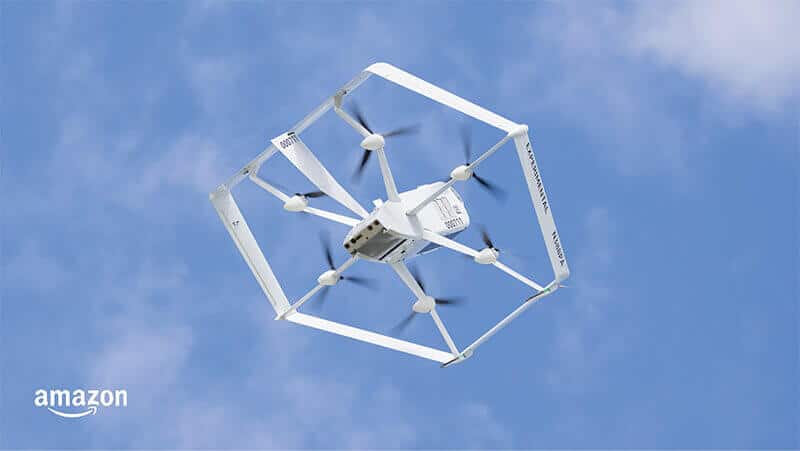
UPDATED: 60-Minute Amazon Drone Delivery is Now a Reality
UPDATE 09/21/2023: The Federal Aviation Administration (FAA) has finally allowed UPS and Zipline to fly commercial drones beyond the visual line of sight (BVLOS) of ground operators, a landmark decision that opens up many opportunities for operators, sellers, and consumers.
What is BVLOS?
BVLOS refers to drone operations conducted beyond the direct visual observation of a spotter manning a designated delivery route. Due to safety concerns involved in flying drones outside the visual range, the FAA has set an extensive process for attaining BVLOS approval, which for months has grounded Amazon’s lofty drone delivery ambitions in the US.
Companies looking to get approved for BVLOS drone delivery must submit detailed documentation of their flight operations, including data on their unmanned aerial vehicles. The aviation rulemaking committee then reviews the application and decides whether to grant approval.
Disruptive Potential of BVLOS in Last-Mile Delivery
With BVLOS approval, UPS and Zipline can now fly delivery drones over longer distances with less manpower.
UPS’s Matternet M2 Drone, for instance, can “carry payloads of up to 2 kilograms (4.4 pounds) over distances of up to 20 kilometers (12.4 miles) over urban and suburban environments.”
Meanwhile, Zipline’s Sparrow drone has been approved by the FAA to make BVLOS deliveries without spotters in Salt Lake City and Bentonville, Arkansas. The drone model is designed to unload packages using a parachute.
“This exemption from the FAA represents a monumental shift for logistics and equitable access in the U.S. It builds the foundation for Zipline to scale to deliver food, medicine, consumer goods and other supplies to millions of Americans on-demand, and to do so in an environmentally conscious way,” said company COO, Liam O’Connor, in a prepared statement.
The FAA making widespread use of commercial drones a reality could make last-mile deliveries more efficient for everyone in the future.
For logistics companies and sellers, last-mile incurs the highest costs and consumes the most time. But drones offer the potential to automate delivery and improve wait times, thereby alleviating pressure on drivers to meet unrealistic quotas and mitigating the customer dissatisfaction associated with shipping delays.
For consumers, it could widen their options for ultrafast delivery outside of Amazon’s logistics network, potentially making deliveries cheaper.
In sum, with the aviation authority and drone operators pushing for advancement in BVLOS capabilities, drone delivery is poised to become a feasible and cost-efficient logistical solution to common supply chain issues across various sectors.
Related: Battle for Last-Mile Logistics Heats Up as Amazon Expands Same-Day Delivery Network
Prime Air, Amazon’s drone delivery service, has finally arrived in California and Texas. 🚀
According to Ars Technica, the online retail giant started flying 5-pound packages by drones to customers in Lockeford, CA and College Station, TX.
With this service, Amazon hopes to speed-up their last-mile deliveries from 1-2 days to less than an hour, especially at a time when they’re reportedly struggling to meet their 2-day delivery promise.
If successful, drone delivery may help Amazon change customer delivery expectations and potentially disrupt the retail industry (once again), aka the Amazon Effect. Why shop in-store when you can get your items delivered right to your doorstep in less than an hour?
In a statement to KTXL Fox 40, Amazon Air spokesperson, Natalie Banke, said that the company’s goal is to safely introduce its drones to the skies. Banke also mentioned expanding drone deliveries to more cities over time.
9 Years in the Making
Prime Air was first revealed by former Amazon CEO Jeff Bezos in a 60 Minutes interview in 2013. Part of the initial plan was to use Octocopters, drones with 8 motors and propellers, to transport lightweight packages to customers in just 30 minutes.
Bezos had estimated that Octocopters will be available to customers in 4 to 5 years, but several technical challenges extended that lead time to 9 years.
In August 2022, Amazon finally got the greenlight from the Federal Aviation Authority (FAA) to fly delivery drones with a maximum payload of 5 lbs each. The said weight represents 85% of the company’s last-mile shipments.
Four months later, the eComm giant’s current model, MK27-2 drones, which are reportedly lighter and quieter than Octocopters, started doing deliveries in California and Texas to help measure buyers’ interest in getting their packages flown over and placed safely into their backyards.

“The drone will fly to the designated delivery location, descend to the customer’s backyard, and hover at a safe height,” Amazon said.
“It will then safely release the package and rise back up to altitude.”
When assessing the safety of drone operations, the FAA takes into the consideration user feedback and all types of potential hazards such as:
- Drones crashing into homes or people
- Propellers causing injuries to people such as cuts and stabs and hearing problems due to engine or prop noise
- Hacking concerns. Drones could be used to hack into computer systems.
- Privacy concerns. Drones can hover over a property or look down into people’s yards.
This is why Amazon continuously develops new tech and redesigns their drones to ensure people feel comfortable receiving packages by unmanned devices.
“While it’s impossible to eliminate all risks from flying, we’re taking a proven aerospace approach to design safety into our system,” Amazon said in a press release dated August 17, 2022.
“Any car you drive is tested—that’s how you know it’s safe. We’re developing our drones in the same way. Just as aircraft manufacturers test their new planes, or automakers test their new vehicles to failure before they go on sale, we test our drones in private and controlled facilities.”
In 2020, the company received a Part 135 Air Carrier Certificate from the FAA. This means Amazon has provided all the required evidence that supports the safety of their drone operations, and thus given permission to “operate as an airline and deliver small packages via drone.”
As of this writing, only Lockeford and College Station residents may sign up for Prime Air. Once signed up, Amazon will then confirm whether they can deliver by drone to the customer’s mailing address. Confirmed orders will also get an estimated delivery time and tracking number.
What’s Next for Prime Air
As Amazon puts it, the MK27-2 drone model is just the beginning. Expect the eComm giant to “constantly redefining, iterating, and experimenting to meaningfully transform the customer experience.”
Amazon also plans to launch its next generation of drones, the MK30, in 2024. Lighter and smaller than the MK27-2, MK30 will have:
- Increased range
- Improved temperature tolerance
- More safety-critical features
- New capability to fly in light rain
With these improved features, customers may feel even more encouraged to select drone delivery over traditional modes of shipping.
Given its potential, we may also see other retailers and legacy carriers offering drone delivery in the coming years.
In fact, corporate giants like Walmart, Alphabet, Domino’s Pizza, and DHL have already taken the first step.
Bulgarian planemaker, Dronamics, is also slated to become the world’s first “cargo drone airline” in 2023. Dubbed Black Swan, the unmanned aircraft is the size of a delivery van and large enough to carry a 770-pound payload and travel across a 1,550-mile range (e.g., Austin, TX to NYC), essentially covering middle-mile shipments.
In sum, it’s an exciting time for the logistics industry as drones could be a safer and faster alternative to existing logistics systems that aren’t as efficient during a pandemic or supply chain crisis caused by labor issues, port congestion, or maritime/air disasters. It will be interesting to see what evolves in this space.
Need more information?
- Send Message: We typically reply within 2 hours during office hours.
- Schedule Demo: Dive deeper into the nuances of our software with Chelsea.
- Join Live Upcoming Webinar: New to Amazon inventory management? Learn three inventory techniques you can implement right away.
 Start Your Free Audit
Start Your Free Audit